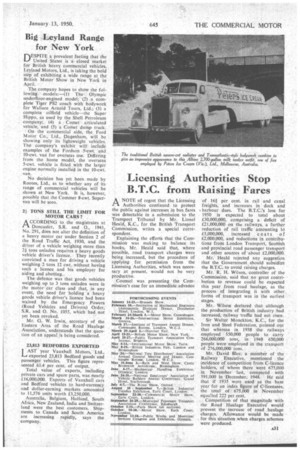Licensing Authorities Stop B.T.C. from Raising Fares
Page 33

If you've noticed an error in this article please click here to report it so we can fix it.
ANOTE of regret that the Licensing Authorities continued to protect the public against increases in bus fares was detectable in a submission to the Transport Tribunal by Mr. Lionel Heald, K.C., for the British Transport Commission, writes a special correspondent.
Explaining the efforts that the Commission was making to balance its books, Mr. Heald said that, where possible, road transport charges were being increased, but the procedure of applying for permission from the Licensing Authorities, which was necessary at present, would not be very productive.
Counsel was presenting the Commission's case for an immediate advance of 161 per cent. in rail and canal freights, and increases in dock and harbour dues. The B.T.C.'s loss for 1950 is expected to total about £30,000,000, comprising a deficit of £21,000,000 on the railways, a further reduction of rail traffic amounting to £5,000,000, increased costs of £2,000,000, and reductions in contributions from London Transport, Scottish and provincial road passenger transport and other sources of about £2,000,000.
Mr. Heald rejected any suggestion that the Government should subsidize the B.T.C. to avoid raising charges.
Mr. R. H. Wilson, controller of the Commission, said that no great contribution to revenue could be expected this year from road haulage, as the process of integrating it with other forms of transport was in the earliest stages.
Mr. Wilson declared that although the production of British industry had increased, railway traffic had not risen.
Sir Walter Monckton, K.C., for the Iron and Steel Federation, pointed out that whereas in 1938 the railways employed 550,000 people to carry 266.000,000 tons, in 1948 650,000 people were employed in the transport of 276,000,000 tons.
Mr. David Bice, a member of the Railway Executive, mentioned the incidence of competition from C-licence holders, of whom there were 675,000 in November last, compared with 591,000 in December, 1948. He said that if 1935 were used as the base year for an index figure of C-licensees, the total of 675,000 in November equalled 222 per cent.
Competition of that magnitude with the Road Haulage Executive would prevent the increase of road haulage charges. Allowance would be made for this situation when charges schemes were produced.




































































































